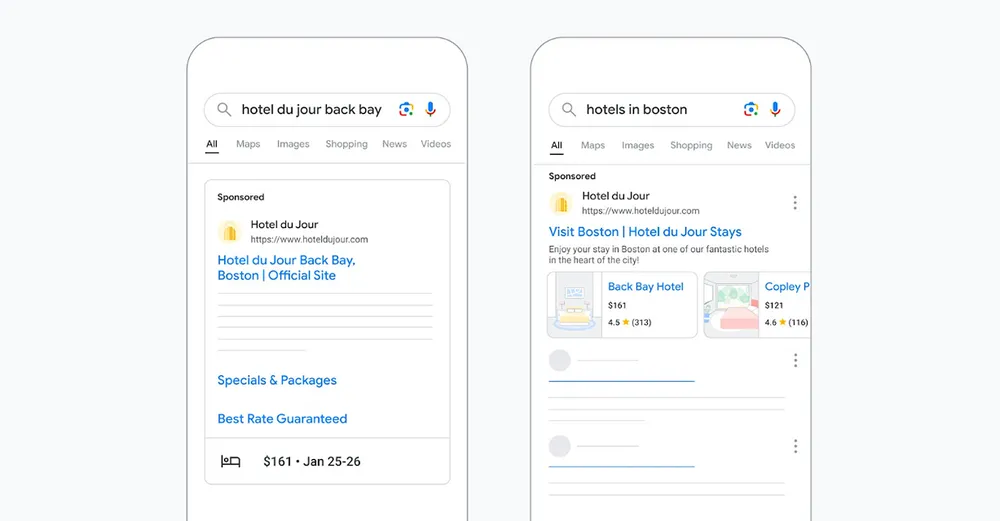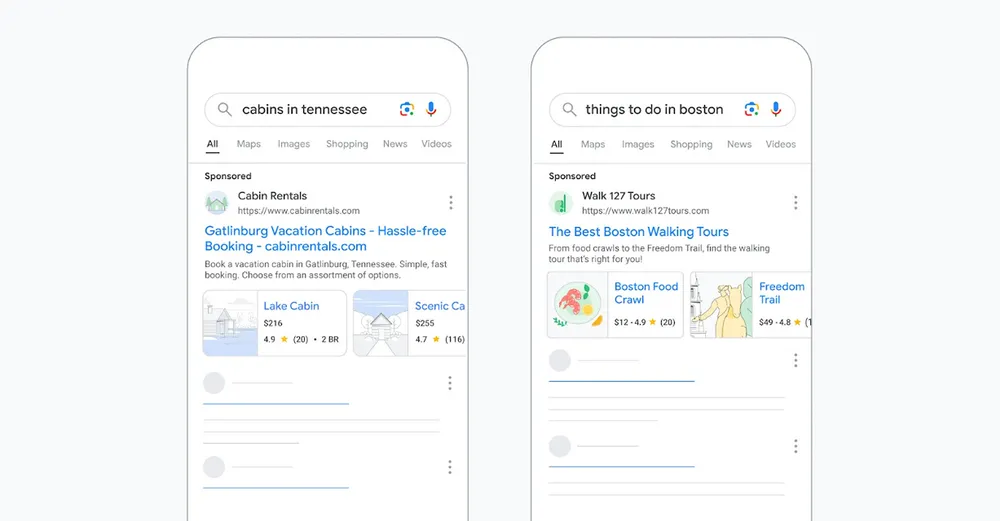Google just rolled out an exciting new tool for hotels and travel-related businesses: Travel Feeds for Search Ads. If you’re trying to reach travelers through Google Ads, you’ll want to know about this feature. Let me walk you through what Travel Feeds are, why they’re worth using, and a special bonus benefit that makes them particularly valuable for hotels.
What are Travel Feeds for Search Ads?
- Travel Feeds display live pricing and details for hotels and activities directly in Search Ads.
- If you’re already using Google travel feeds, your data will automatically appear in all campaigns.
- New to feeds? Setup is quick, with simple opt-out options at any level.
For Hotels: You can now showcase feed data, such as hotels, prices, dates, ratings and images

Source: Google
Other Businesses: You can also setup feeds for things to do, car rentals, and events

Source: Google
Should you utilize Travel Feeds for Search Ads?
Primary Benefit:
During Google’s initial testing of this new ad format, advertisers saw impressive results – a 20% boost in click-through rates. That’s significant news for hotels and resorts who are constantly competing for visibility against online travel agencies (OTAs) and other properties. Higher click-through rates mean more qualified travelers landing on your website, and ultimately, more direct bookings.
Bonus Benefit:
I know this is counterintuitive to the primary reason, but it should prevent unwanted clicks and make your ad spend more efficient. When your ad budget is only attracting genuinely interested visitors to your website, every dollar works harder for you. This efficiency might even let you experiment with broader audience targeting that previously wasn’t cost-effective. Let me show you some examples of how this works in practice.
Travel Feeds for Search Ads in Action: Real Examples
- Luxury Hotels: Having your rates displayed upfront actually works in your favor for luxury properties. When potential guests see higher prices immediately, those seeking budget options will scroll past – saving you from paying for clicks that were never going to convert. Instead, your ads will attract travelers specifically looking for upscale accommodations. Remember those broader search terms you might have given up on, like “hotels in [city]” or “hotels near [landmark]”? With pricing now visible in your ads, these general keywords might finally deliver the return on investment you’ve been looking for, potentially allowing you to expand your reach and boost bookings.
- Budget Hotels: While well-known hotel chains often attract immediate recognition and clicks, smaller, budget-friendly properties have their own unique challenges. If you’re running an independent hotel with a limited marketing budget, it’s crucial to attract the right guests while maintaining efficient occupancy rates. Rather than casting a wide net with general targeting, you might find better results by focusing on specific search phrases like “hotels near [landmark]”. It’s worth experimenting with these targeted approaches to see what works best for your property.
With Travel Feeds for Search Ads, Google has introduced a powerful tool that benefits both travelers and advertisers. Whether you’re managing a luxury resort or a boutique budget hotel, this feature helps you reach the right audience more efficiently. By displaying key information upfront, you’ll likely see improved click-through rates while reducing wasted ad spend on unqualified leads. Stay tuned as we discover new ways to leverage this exciting feature – the possibilities for smarter, more targeted travel advertising are just beginning to unfold. Additionally, the integration of Travel Feeds into your marketing strategy can provide valuable insights into traveler behavior, allowing for more tailored advertising approaches. By focusing on key demographics and booking trends, you can implement maximizing hotel occupancy tips that cater directly to the needs of your potential guests. As we adapt to this evolving landscape, innovative strategies will become essential for making every marketing dollar work harder for your business.
I’m an SEO and performance marketing leader who loves breaking down complex strategies into clear, actionable insights. I have driven growth for reputable brands such as SAP, Four Seasons, BioMarin Pharmaceutical, and Rosewood Hotels in SEO and Performance Marketing strategy.

